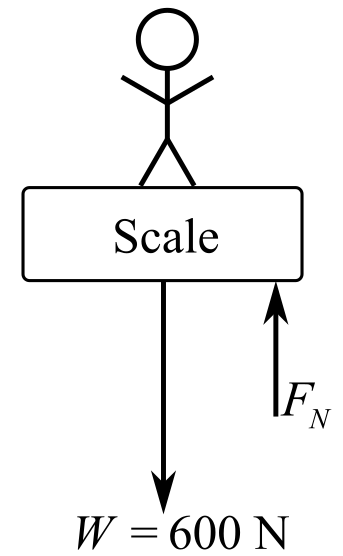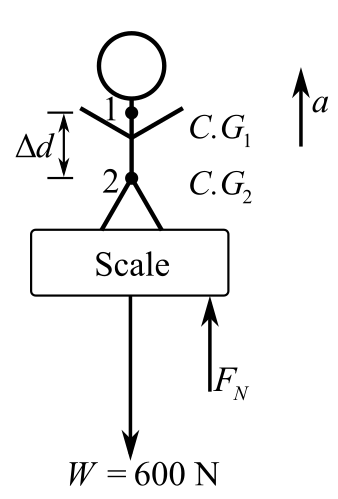
Concept explainers
A person stands on a scale, which then reads 600 N. (a) What force is exerted on the scale by the person? (b) What force is exerted on the person by the scale? (c) What would happen to the reading as the person began to jump straight up?
(a)
The magnitude of the force applied on the scale by the person if he stands on a scaleand the readingis
Answer to Problem 9SP
Solution:
Explanation of Solution
Given data:
The weight of the person is
The scale is at rest, so there will be no acceleration.
Formula used:
Write the expression for the first condition of force equilibrium:
Here,
Explanation:
Draw the free body diagram of the scale when the person stands on it:

In the diagram,
Recall the expression for the first condition of force equilibrium:
Consider that the direction of the upward forces is positive and the direction of the downward forces is negative. Therefore,
Substitute
From Newton’s third law, the force exerted on the scale by a person is equal and opposite to the weight of the person and it acts in the downward direction because the force applied by the person is in the downward direction. So, the magnitude of force applied by the person to the scale should be equal to the normal reaction force applied by the contact surface of the scale to the person.
Conclusion:
The magnitude of the force applied on the scale by the person is
(b)
The magnitude of the force applied on the person by the scale if he stands on a scale and the scale reads
Answer to Problem 9SP
Solution:
Explanation of Solution
Given data:
The weight of the person is
The scale is at rest, so there will be no acceleration.
Formula used:
Write the expression for the first condition of force equilibrium:
Here,
Explanation:
Draw the free body diagram of the scale:

In the above diagram,
Recall the expression for the first condition of force equilibrium:
Consider that the direction of the upward forces is positive and the direction of the downward forces is negative. Therefore,
Substitute
From Newton’sthird law, the force exerted on the person by the scale is equal and opposite to the weight of the person and it actsin the upward direction because the force exerted by the scale is in the upward direction.
Conclusion:
Therefore, the magnitude of the force applied on the person by the scale is
(c)
The reading on a scale when the person begins to jump straight up on a scale.
Answer to Problem 9SP
Solution:
Increase
Explanation of Solution
Given data:
The weight of the person is
The scale is at rest, so there will be no acceleration.
Formula used:
Write the expression for Newton’s second law of motion:
Here,
Explanation:
Draw the free body diagram of the person when he begins to jump:

In the diagram given above,
Recall the expression for Newton’s second law of motion along the vertical direction:
Consider that the direction of the upward forces is positive and the direction of the downward forces is negative. Therefore,
Here,
Conclusion:
Therefore, as the person starts to jump straight up, the reading of the scale would increase.
Want to see more full solutions like this?
Chapter 4 Solutions
Schaum's Outline of College Physics, Twelfth Edition (Schaum's Outlines)
- Does the ground need to exert a force on you for you to jump off the ground, or do you need to exert a force on the ground? If the ground must exert a force on you, is that force greater than the force you exert on the ground?arrow_forwardFor the woman being pulled forward on the toboggan in Figure 4.33, is the magnitude of the normal force exerted by the ground on the toboggan (a) equal to the total weight of the woman plus the toboggan, (b) greater than the total weight, (c) less than the total weight, or (d) possibly greater than or less than the total weight, depending on the size of the weight relative to the tension in the rope?arrow_forwardA crate remains stationary after it has been placed on a ramp inclined at an angle with the horizontal. Which of the following statements must be true about the magnitude of the frictional force that acts on the crate? (a) It is larger than the weight of the crate. (b) It is at least equal to the weight of the crate. (c) It is equal to sn. (d) It is greater than the component of the gravitational force acting down the ramp. (e) It is equal to the component of the gravitational force acting down the ramp.arrow_forward
- A large crate of mass m is placed on the back of a truck but not tied down. As the truck accelerates forward with an acceleration a, the crate remains at rest relative to the truck. What force causes the crate to accelerate forward? (a) the normal force (b) the force of gravity (c) the force of friction between the crate and the floor of the truck (d) the ma force (e) none of thesearrow_forwardA black widow spider hangs motionless from a web that extends vertically from the ceiling above. If the spider has a mass of 1.5 g, what is the tension in the web?arrow_forwardThe helicopter view in Fig. P3.15 shows two people pulling on a stubborn mule. The person on the right pulls with a force F1 of magnitude 120 X and direction of 1 = 60.0. The person on the left pulls with a force F2 of magnitude 80.0 N and direction of 2 = 75.0. Find (a) the single force that is equivalent to the two forces shown and (b) the force that a third person would have to exert on the mule to make the resultant force equal to zero. The forces are measured in units of newtons (symbolized N). Figure P3.15arrow_forward
- A large crate of mass m is placed on the flatbed of a truck but not tied down. As the truck accelerates forward with acceleration a, the crate remains at rest relative to the truck. What force causes the crate to accelerate? (a) the normal force (b) the gravitational force (c) the friction force (d) the ma force exerted by the crate (e) No force is required.arrow_forwardAn object experiences no acceleration. Which of the following cannot be true for the object? (a) A single force acts on the object. (b) No forces act on the object. (c) Forces act on the object, but the forces cancel.arrow_forwardDetermine whether each of the following statements is true or false. a. An objects weight is always equal to its mass. b. The force of tension always pushes. c. The magnitude of the sum of the forces on an object is never greater than its weight. Explain.arrow_forward
- The manager of a department store is pushing horizontally with a force of magnitude 200 N on a box of shirts. The box is sliding across the horizontal floor with a forward acceleration. Nothing else touches the box. What must be true about the magnitude of the force of kinetic friction acting on the box (choose one)? (a) It is greater than 200 N. (b) It is less than 200 N. (c) It is equal to 200 N. (d) None of those statements is necessarily true.arrow_forwardA 3.00-kg object is moving in a plane, with its x and y coordinates given by x = 5t2 1 and y = 3t3 + 2, where x and y are in meters and t is in seconds. Find the magnitude of the net force acting on this object at t = 2.00 s.arrow_forwardWhich of the following statements is most correct? (a) It is possible for an object to have motion in the absence of forces on the object. (b) It is possible to have forces on an object in the absence of motion of the object. (c) Neither statement (a) nor statement (b) is correct. (d) Both statements (a) and (b) are correct.arrow_forward
 Principles of Physics: A Calculus-Based TextPhysicsISBN:9781133104261Author:Raymond A. Serway, John W. JewettPublisher:Cengage Learning
Principles of Physics: A Calculus-Based TextPhysicsISBN:9781133104261Author:Raymond A. Serway, John W. JewettPublisher:Cengage Learning Physics for Scientists and Engineers: Foundations...PhysicsISBN:9781133939146Author:Katz, Debora M.Publisher:Cengage Learning
Physics for Scientists and Engineers: Foundations...PhysicsISBN:9781133939146Author:Katz, Debora M.Publisher:Cengage Learning College PhysicsPhysicsISBN:9781285737027Author:Raymond A. Serway, Chris VuillePublisher:Cengage Learning
College PhysicsPhysicsISBN:9781285737027Author:Raymond A. Serway, Chris VuillePublisher:Cengage Learning College PhysicsPhysicsISBN:9781305952300Author:Raymond A. Serway, Chris VuillePublisher:Cengage Learning
College PhysicsPhysicsISBN:9781305952300Author:Raymond A. Serway, Chris VuillePublisher:Cengage Learning Glencoe Physics: Principles and Problems, Student...PhysicsISBN:9780078807213Author:Paul W. ZitzewitzPublisher:Glencoe/McGraw-Hill
Glencoe Physics: Principles and Problems, Student...PhysicsISBN:9780078807213Author:Paul W. ZitzewitzPublisher:Glencoe/McGraw-Hill Physics for Scientists and EngineersPhysicsISBN:9781337553278Author:Raymond A. Serway, John W. JewettPublisher:Cengage Learning
Physics for Scientists and EngineersPhysicsISBN:9781337553278Author:Raymond A. Serway, John W. JewettPublisher:Cengage Learning





